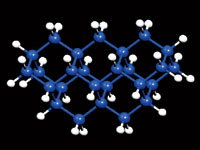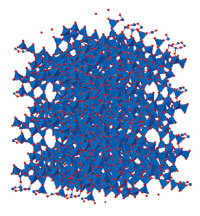What's new in production
Diamondoid update. If one takes to heart the musings of the general media, the worst element on the planet is carbon, especially oxide of carbon. However, an old song prized and celebrated carbon: “Diamonds are a girl’s best friend.” In the oilfield, for cutting ability, wear resistance, and heat tolerance, natural diamond and man-made diamond cutters have a hallowed place in the driller’s heart. Carbon also has good electrical conductivity, so is suitable for high-temperature electrical products.
Carbon is a most useful element. Three years ago World Oil brought the news of diamondoids to your attention (World Oil, January 2003, p. 17). These are hydrocarbons with the chemical structure C4n+6H4n+12 that occur naturally in oil and gas. A gallon of condensate can carry a couple of spoonfuls of diamondoids, according to Chevron, Adamantine (C10H16, similar in shape to a diamond and less than a billionth of a billionth of a carat in weight) and larger diamondoids can precipitate along with asphaltines during production, so they can be a problem. MolecularDiamond Technologies (MDT), a unit of Chevron Technology Ventures LLC, first separated diamondoids from petroleum using reverse-phase, high-performance liquid chromatography. The company has since improved its separation techniques into a continuous process and is producing enough diamondoid material for advanced application research and development. They’ve also concentrated useful quantities of the larger diamonoids. Now, MDT and Stanford University are moving to explore the uses of diamondoids through a four-year, nanotechnology research program. The program will build upon recent MDT discoveries and focus on:
It is this monolayer self-assembly property that holds great promise for building extremely hard diamondoid objects layer by layer, similar to the way microchips are built with silica. Diamondoid-backed films with different properties could be created to meet many oilfield needs, especially for lubrication, wear surfaces or high temperature environments. We’ve barely scratched the surface of diamondoid potential.
Stranded methanol/ gasoline. While we are on the subject new compounds, another useful compound class is zeolites, which are hydrated alumino-silicates. They have an open molecular structure that allows positive ions to be exchanged for others, making zeolites good catalysts. The molecule’s lattice has channels through which small molecules can pass. As natural gas molecules move through the channels they react to form longer chain hydrocarbons, Fig. 2. Someday, portable catalytic systems, using such molecular sieves, will convert stranded natural gas directly to gasoline. Most existing gas-to-liquid plants use the Fischer-Tropsch process, which requires high temperatures and iron-based catalysts, as well as a large footprint for the plant. One company, Syntoleum, has produced barge-based GTL systems to develop smaller gas fields that are not suitable for LNG development. But, what if an operator could produce gas, flow it through a modest plant and collect liquid fuel for direct sale? Several projects have already been tried. One facility at Montunui, New Zealand was originally designed to produce gasoline from natural gas using catalyst ZSM-5, Mobil’s synthetic zeolite. The Mobil process first converts the gas to methanol. That methanol is then dewatered into dimethyl ether, which the ZSM-5 catalyst converts to high-octane gasoline. Only three reactions are needed. The gasoline produced can be used as blending stock, because it is 80% C5 plus other hydrocarbon products. Market forces made New Zealand gas-to-gasoline project more economic as a gas-to-methanol plant, so the plant was sold to Methanex, who now operates the facility. Projects like this point the way to the eventual development of stranded gas reserves across the globe. Stranded gas reserves will likely be developed using some effective new zeolites. In a related development, a team of Korean scientists at the Korea Advanced Institute of Science and Technology has produced a new zeolite catalyst that they claim is much more effective than those commonly used for refining. The team produced a zeolite with a much higher reaction rate, from 1.5 to dozens of times faster, according to Prof. Ryoo Ryong, director of the Center for Functional Nanomaterials, who led the team. Normal zeolites have pores from 0.3 to 1.5 nanometers in diameter, too small for many hydrocarbon types to pass through. Ryong’s team was able to synthesize zeolites with pores up to 10 nanometers across. This large diameter allows many intermediate crudes to be converted to lighter products much more
|
||||||||||||||
- What's new in production (February 2024)
- U.S. operators reduce activity as crude prices plunge (February 2024)
- U.S. producing gas wells increase despite low prices (February 2024)
- U.S. oil and natural gas production hits record highs (February 2024)
- Dallas Fed: E&P activity essentially unchanged; optimism wanes as uncertainty jumps (January 2024)
- Enhancing preparedness: The critical role of well control system surveys (December 2023)
- Applying ultra-deep LWD resistivity technology successfully in a SAGD operation (May 2019)
- Adoption of wireless intelligent completions advances (May 2019)
- Majors double down as takeaway crunch eases (April 2019)
- What’s new in well logging and formation evaluation (April 2019)
- Qualification of a 20,000-psi subsea BOP: A collaborative approach (February 2019)
- ConocoPhillips’ Greg Leveille sees rapid trajectory of technical advancement continuing (February 2019)






